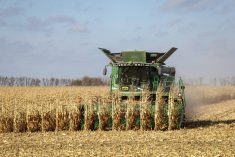It’s a simple question, one that Martin Entz hopes producers will seriously consider.
“Why not grow organic soybeans?” he asked producers gathered at the Ian N. Morrison research farm near Carman late last month for the Manitoba Pulse & Soybean Growers’ annual SMART Day.
“Something farmers are always looking for is on-farm diversification, so we’ve been working with farmers to help them shift part of their farm operation to certified organic as a form of diversification,” said the University of Manitoba plant science professor. “Doing this is possible; it works.”
Read Also

Still hard to predict precise fertilizer payback
Despite decades of advances, international research finds no clear answer for where and when adding nutrient will fail to boost growth.
Research on organic soybean production has been ongoing at the site for about a decade, and over the last eight years the average yield has been 28.7 bushels an acre using OAC Prudence, Entz said.
And while those yields are lower than conventional soybeans, he added that the premiums for organic beans make the venture worthwhile.
“The price for organic soybeans right now… is about $26 to $30 a bushel, depending on if it’s food grade or feed,” he said, adding that demand is also high.
An ongoing project backed by the university, the Western Grains Research Foundation and the pulse growers’ association assists interested farmers in transitioning a portion of their farm to organic by providing guidance and individual, one-on-one farm plans.
“Soybeans are our most consistent organic crop, so there is potential here,” he said. But he added that success requires management practices that might be new to producers, such as in-row flame weeding. Inter-row tillage is also effective for managing weeds in organic soybeans, he said.
“If you’re not using herbicides, the danger of wide-row soybeans doesn’t apply,” he explained, referring to the development of resistant weeds in conventional row crops. “If you’re growing them organically, you should use inter-row cultivation, so space them as close as you can, while still allowing for that cultivation.”
Effective crop rotation also plays a crucial role in organic soybean management, Entz said. And while some might think corn isn’t an option in organic rotations, Entz told producers to think again.
Holding up a lengthy corn plant, he said, “some of you who grow soybeans are also interested in growing corn, and there are corn alternatives as well. This is actually an open-pollinated food-grade corn.”
Variety selection

Choosing the right soybean variety is also important. Student researcher Michelle Carkner is working to identify which varieties are best suited to Manitoba, using plots at the research farm as well as at producer sites.
“We’re still learning things about growing soybeans conventionally, we’re learning even more about growing organic soybeans,” said Carkner.
Trials have looked at the effectiveness of OAC Petrel, Toma, Tundra, Krios, Jari, Auriga, Savannah and SK0007 plus new and unregistered varieties in the hopes of finding the right fit for organics in Manitoba’s shorter growing season.
One thing that’s become apparent is that higher seeding rates increase yields and decrease weed pressure in organic beans.
“And because the price of organic soybeans is so high, growers can get their money back when they increase seeding rates,” she said.
Some producers at the demonstration were concerned about the 36-months transition to organic, a period when crops must be produced organically, but can’t be sold for a premium.
Entz said that by doing a farm plan, and looking at transition strategies that could be managed, and Carkner agreed.
“That’s why people might want to look at starting with part of their farm, maybe putting it into a green manure first, there are ways,” she said, adding some buyers will also offer premiums during the 36 months to bring more organic production online.















